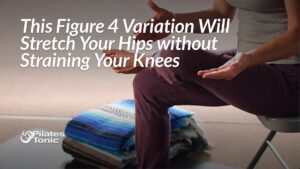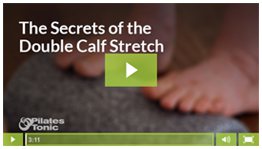 At Pilates Tonic we require that you take at least one private session before you take a regular class, even if you're a Pilates pro.
At Pilates Tonic we require that you take at least one private session before you take a regular class, even if you're a Pilates pro.
There are many reasons I’m so insistent about this, but first on the list is your safety. And first on the safety list is learning how to activate subtle muscle systems so that you can perform every exercise we throw at you correctly and get maximum benefit from your effort.
Mastering the basics will help you avoid damaging many body parts, but in this article we’re going to look at how to avoid damaging your pelvic floor. You might be surprised to learn just how common a problem this is in many fitness circles, not just Pilates.
Strong Abs Don't Equal Core Strength
Pilates has become synonymous with the idea of core strength, and core strength has become misunderstood in the fitness industry; many think it's all about strong abs.
What we consider your core at Pilates Tonic is much more than mere abdominals. Your core actually includes the multifidi (deep back muscles), diaphragm (your breathing muscle), transverse abdominis (or TA, the deepest layer of your abs), your psoas major, and your pelvic floor.
Not one of these muscle groups is more important than another, not even the most popular one, the transverse abdominis, or TA, which has gotten the most media attention during the last decade.
Optimally, all of these core muscle groups work together in a unified and balanced way, like a chorus. The TA is just one small voice in that chorus and the TA can't sing in harmony with itself.
This core group of “voices” creates internal pressure in your body which supports your internal organs, keeps them healthy, and helps to prevent them from falling out through the bottom of your pelvis.
For some people, the connections among these core muscles have started singing out of tune because of poor posture habits, or injury. When this happens, it's vital to reawaken the parts that have gone to sleep or gotten out of balance and get them back in tune before we start building strength on top of them.
In other words, before you do that massive new workout routine you’ve been planning, you absolutely must have your core muscle connections aligned and balanced and activating in harmony.
Once you’ve got the core systems in tune again, we invite the other, more external muscle groups to join in through different exercises and movements.
So How Does this Relate to My Pelvic Floor?
If you're used to engaging your abdominals more externally, rather than internally, it’s likely you’re already running into trouble, you just might not realize it yet.
For example, a very popular cue to engage your abdominals is to “pull your navel to your spine,” or to “scoop in” your abdominals. The response these cues often create is an engagement from the navel line using the external obliques instead of connecting lower and deeper in the abdomen with the TA.
You’re a Lot Like a Tube of Toothpaste
To visualize what's happening when you activate your abdominals incorrectly, think about what happens when you squeeze a tube of toothpaste from the middle instead of squeezing from the bottom up.
Squeezing from the middle not only makes a mess, but eventually, if you were to squeeze it hard enough, would cause the toothpaste to squirt out the bottom.
The toothpaste represents your internal organs and the bottom of the toothpaste tube is your pelvic floor.
Your pelvic floor muscles are located at the bottom of your pelvis and both men and women have them. They close up the hole at the bottom of your pelvic bones and prevent your internal organs from falling out through the bottom of your pelvis.
When you engage the abdominals externally, it's like squeezing your toothpaste from the middle. Not good!
If you keep doing this over and over again, especially when you add exercises that involve abdominal curls to the mix, your pelvic floor is eventually going to weaken and give way somewhere. You could end up with a prolapse of an organ, or with an incontinence issue.
Improper abdominal activation will also have a major impact on how you’re able to maintain overall body alignment.
Your ultimate goal is to engage your abdominals internally, rather than externally.
How Can You Tell if You’re Engaging Your Abs Externally?
If you're used to engaging your abdominals externally, it can be hard to retrain this habit; especially because engaging externally still feels like ab work and will make your stomach sore the next day. This gives you the feeling that you’ve successfully “worked” your core.
A quick way to tell if you’re engaging externally instead of internally is to place your hands on your lower belly, right above your pubic bone. Engage your abs like you normally do and feel what happens.
If you felt your belly push out against your hand, even a little bit, you’re engaging from your internal and/or external obliques. This is not what you want.
If this is how you’re used to engaging your abs, you’ll need to work on developing a new awareness around connecting from the deepest abdominal, your transverse abdominis, instead.
Watch this video to learn how to better connect with your TA; it guides you through some imagery I've found to be very effective in helping people reconnect to their TA properly.
You Can Also Find the TA Through the Back Door
Another really fantastic way to find your TA is with your multifidus. Remember the “core chorus” from earlier? Well, the mulitifdus is the conductor of that chorus.
When you activate your multifidus, your TA is automatically activated correctly as well—it just naturally comes along for the ride.
I demonstrate this alternate technique for finding and activating your multifidus in this video. If you're having trouble finding your TA, this one should help a lot. Let me know how it works for you.
Keep an Eye on Your Breath Too
You'll also want to consider the way you're exhaling when you make this internal connection. A forceful exhale, or pushing all of the air out of your lungs, is going to cause you to directly activate your external obliques. You don't want this.
Try using a softer, lighter exhale from the back of your throat until your new TA connection is well established.
Second Nature Before You Know It
It’s not that you don’t want to work your obliques and rectus abdominis at all, you just want to ensure you're working from the inside out and developing a healthy, harmonious chorus of internal muscle connections.
Once you’ve established your connections and are able to maintain them, then heck yeah, we look at adding all kinds of fun exercises into the mix!
If you still have any questions about any of this, please let me know in the comments below. It can be a lot to consider, especially if these concepts are new.
Once you get the hang of it, it really does become second nature and your efforts in the gym, on the mat, or anywhere else you use your body become safer and more rewarding!
See you in the studio,
Sydney







10 Responses
What a great article! I just found it through facebook and loved your explanation. As an instructor myself I always work with my clients (especially the new ones) on discovering their true core. Once they get it right, it changes their full perception of movement.
Thank you! I really enjoyed reading and watching the videos.
Thank you Anastasiya! I’m glad you enjoyed the article and videos. Thank you for sharing your feedback 🙂
Great combo of anatomical terms and visual imagery:) I pound this issue home with my clients, but become saddened when I encounter those students who haven’t had a good education regarding this crucial component!
Thank you for your feedback Amanda! I’m glad you enjoyed the post.
Great article. Could you please cite your sources?
Hi Jessica, A lot of my inspiration comes from working with Marie-José Blom, who’s been greatly inspired by Diane Lee. Some of my other resources, Blandine Calais-Germain’s Anatomy of Breathing and No-Risk Pilates, as well as Joesphine Key’s ‘The Core’: Understanding It, and Retraining its Dysfunction. Thanks for your question!
Thank you so much for this article.
I found it really interesting and have enjoyed playing with it.
My first point if note is with the multifidus exercise.
Following that I performed the breast stroke prep and as the elevator lifts the shoulder blades naturally draw down and the neck lengthens.
Regarding the activation of the TA with its smile. I really enjoyed it. However I began first by introducing the pelvic floor. I do this by using Tasha Lawson’s cues which seem to work. ” imagine you have a straw in your vagina, breathe in and as you breathe out try to suck a pea towards you”
I find this cueing works as the glutes stay fairly relaxed.
I must also add I did explain this along with the smile was a gentle activation to help hold the neutral pelvis. This is what I feel – am I correct?
Add to this the activation of the multifidus and the sinking of ribs towards hips and I found imprint. Again am I correct in this assumption?
Very interesting ideas cues and thoughts and provided a lot of exploration.
Many thanks.
Hi Michaela, I’m glad you enjoyed the article and have enjoyed exploring the ideas. Something I’ve found really interesting with regards to the mulitfidus, TA and PF, is they co-activate. The multifidus leads the way. So if you get the multifidus first, the TA and PF come along naturally, and often you don’t even have to cue them because they are already on board. Thank you for your feedback!
OMG, WOW! 🙂
Really useful article – I’d like to post a link to this on my website – would that be ok please?
Regards – Simon | Adelaide
Hi Simon, Glad you found the article useful! Sure, you can post a link to the article on your site. Thank you! 🙂